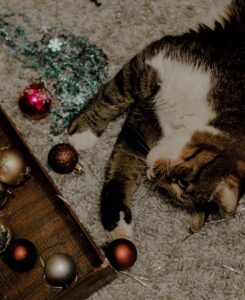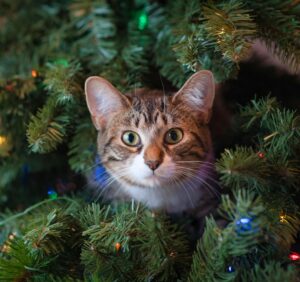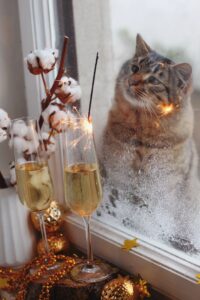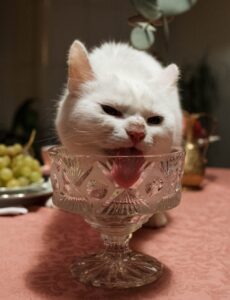The holiday season is upon us again, so it is time to remember the potential hazards it brings to the health and safety of our feline friends. Here are a few tips:
 Tinsel, String, and Ribbons.
Tinsel, String, and Ribbons.
Strings and ribbons are fascinating to cats and often part of a good toy. Catnip mice can have long ribbon tails, balls of yarn are old cat toy classics, and wand toys with soft balls or feathers dangling from a string can keep cats entertained for hours. Kittens and young cats are easily enticed by a piece of string, especially if it is shiny or moving, and they look incredibly cute when playing with it. Therefore, it can seem harmless to let your cat chase a piece of holiday ribbon across the floor, rummage around discarded gift-wrapping material, or play with a ball of tinsel. However, string, ribbons, and tinsel can be hazardous to cats. When swallowed, these foreign bodies can become entangled in the intestinal tract. The body will try unsuccessfully to pass the string or ribbon, leading to inflammation or damage to the intestinal wall. The rough, abrasive material can even cut through the intestinal wall, and if this happens, it is a life-threatening situation that requires emergency surgery. When playing with string, cats should not be left alone. They should always be supervised to prevent accidents from happening. This is especially true during the holiday season, but if you use wand toys daily to entertain your cat, put them away in a safe place once playtime is over.
 Electrical Cords and Candles.
Electrical Cords and Candles.
Dangling electrical cords or exposed extension cords invite the same kind of play as a piece of string or ribbon. Cats like to bat at them, chase them, or chew on them. The latter is especially true for young kittens that are teething. Cat teeth are very sharp, so they can easily penetrate the insulation around any type of electrical cord. If that happens, it can cause severe burns to the tongue or life-threatening electrical shocks that require immediate medical care.
Candles are beautiful to look at but should never be left unattended around cats. Curious cats often find dancing flames irresistible and will choose to explore them. This can result in serious burns. Cats can also knock candles over with a flick of their tail, thereby setting more than themselves on fire. For those reasons, battery-powered candles are the safer choice in a cat household.
 Seasonal Plants and Trees.
Seasonal Plants and Trees.
Christmas lilies, Peace lilies, and other members of the lily family are extremely poisonous to cats. Ingesting a piece of a lily plant can cause cats to have seizures or develop lasting kidney or liver damage. Depending on the type of lily, every part of the plant may be poisonous, even the water in the vase or pot you keep them in. Mistletoe is another plant to avoid. There are several types of mistletoe, some that only cause irritation of the intestinal tract when ingested, and others that may bring about seizures and organ failure. Holly can give cats gastrointestinal problems, such as vomiting and diarrhea. It can also cause severe irritation in the mouth. The same is true for Poinsettia sap, though it is not as toxic to cats as it is rumored to be.
Fir, spruce, and pine are the most common trees used during the festive season. Some cats, including Maine Coons and Norwegian Forest Cats, can be especially attracted to pine needles and may insist on eating them. Fir, spruce, and pine needles are all mildly toxic to cats due to the oils inside. They can also cause gastrointestinal upset and irritation to the mouth if ingested. Lastly, the water in your Christmas tree stand can contain remnants of harmful fertilizer from the tree and may become a breeding ground for bacteria. Both will give your cat an upset tummy if they have free access to it and decide to drink it.
 Chocolate and Sweets.
Chocolate and Sweets.
Chocolate contains a chemical called theobromine which is dangerous to cats. It has caffeine-like properties and is used medicinally for several purposes, including as a heart stimulant and a muscle relaxant. The toxicity of chocolate depends on the type of chocolate in question and the age and size of the cat, but regardless, cats should never have access to any chocolate products. An 8-week-old kitten weighing around 2 pounds can be poisoned by only 1 ounce of milk chocolate. Clinical signs of chocolate poisoning include hyperexcitability, nervousness, vomiting, and diarrhea. In severe overdoses, the only symptom may be sudden death.
Sweets wrapped in crinkly paper sound like fun toys to cats, but they pose a choking hazard. Cats may accidentally ingest them while pawing at them or batting them across the floor. To be safe, all bowls, boxes, or bags of sweets should be kept out of your cat’s reach.
 Holiday Dinner.
Holiday Dinner.
Since cats are loved family members, we often wish to include them in our holiday meals. This is not necessarily a bad idea, just bear in mind that sudden rich diet changes will upset your cat’s stomach. A small amount of lean meat is a good special treat, but if you feed leftovers high in fat, your cat’s pancreas may become overworked and inflamed. This condition often requires hospitalization and intensive medical care.
General Cat Safety.
Christmas trees should be secured to prevent them from falling over if an overexcited feline decides to climb to the top. Cats do not always land on their feet and can get hurt in tree-related accidents. Fragile ornaments should be kept away from curious cat paws, and any string used in the preparations of roasts and turkeys should be disposed of in sealed garbage containers. Most cats will not be able to resist digging them out of the trash, and since they smell so yummy might decide to eat them. In general, it is a good idea to keep your cat out of the kitchen whilst cooking big meals. You do not want to risk them getting burned, stepped on, or otherwise injured in the hustle and bustle of the preparations.
We would like to wish everyone a pawsome holiday season!



